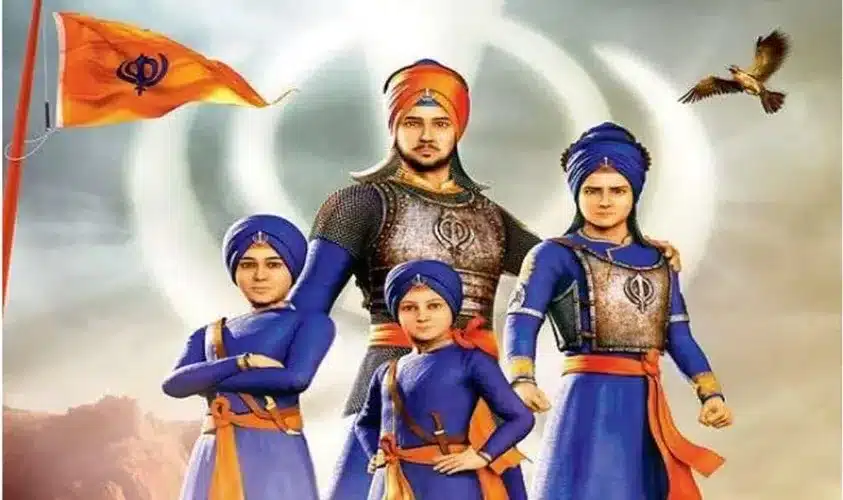Historical Narrative of Veer Bal Diwas

Historical accounts of the transformation of Sikhism as a life philosophy are instructive and extremely eye-opening. Initially, those who drew towards the Sikhism of Guru Nanak dev [its exponent] by instinct they were peace-loving and religiously devotional. But later the way with heart-rending cruelty first Guru Arjundev was killed by Jahangir and then Guru Tegbahadur by Aurangzeb the course of Sikhism changed. See- ‘The fifth guru, Arjun Singh(Guru Arjundev), compiled the Granth( Guru Granth Sahib). And Granth is a collection of sayings and hymns and the sacred books of the Sikhs. For a political offence Jahangir had Guru Arjun Singh tortured to death. The unjust and cruel treatments of their Guru filled Sikhs with resentment and turned their minds to arms.’ ( P- 371; Glimpses of World History: Jawaharlal Nehru)
It was no longer untenable to Sikhs to have learned that bhajans[devotional songs], keertan [prayers] and fast may bring spiritual peace to mind; but as far as the security of the community is concerned that can’t be achieved without arousing the spirit of the organization, fearlessness, and materialism among the people. And to fulfill that aim the ‘Khalsa-pantha’ came into existence, the founder of which was none other than Guru Govind Singh. First, five who came forward to fulfill the resolutions of Khalsa were venerably known as ‘Panj-pyare’. One among them was from Dhobi-community; second, Bhisti; third, Darji; fourth, khatri; fifth from the Jat community. Also, three among them were from Beedar, Dwarkapuri and Jaggannathpuri; and the other two were from Punjab. Having been initiated in Khalsa, it was mandatory to keep kesh[long hair], kataar [dagger], and kangi [comb]; and wear kachha [small piece of loin-cloth] and kada [bracelet], which are popularly known as five ‘kakaar’’.
It was the time when people were subject to bear insult and atrocities at the hands of the Mughals on the basis of religion. Guru Govind Singh resolved to change the prevailing estate of affair. Then what-there began a sequel of battle after battle against Mughal commanders, and against those kings who were indulged in appeasing Mughals in order to anyhow save their respective territories. He successfully won the First, Second, and Third battles of Anandpur and of Nirmohgarh prominently. The increasing influence of Guru Govind Singh forced Aurangzeb to change his strategy. He issued order to the commanders of Sarhind, Lahore, and Jammu to jointly launch an attack on Guru Govind Singh. Consequently, war broke out first at Anandpur, and then at Chamkore. Foreboding the ferocity of war Guru Govind Singh sent his mother and his sons, eight years old Joravar Singh and five years old Fateh Singh, with his trusted servant to his native village. Here in the famous battle of Chamkore with Guru Govind Singh were 40 dedicated fighters led by the rest of his two sons — Ajit singh and Jujhaar Singh, to face 700 Mughal soldiers. In the fierce battle lasted only for a day both the brave sons became martyred. With the remaining fistful of soldiers, Guru Govind Singh receded from here to take refuge in Khidrana. On the other side, the servant despatched for the native village turned traitor, and handed over his sons [Joravar and Fateh Singh] to the Commander of Sarhind, Vazir Khan. He called the meeting of Kaazis and Ulemaas, in which an order was issued to both sons to either adopt Islam or embrace death. Sons preferred death to leave their Dharma, consequently, they were buried alive in the wall on 26 December 1704.
Latter one more battle was fought with the Mughals in Khidrana, in which Guru Govind Singh emerged victorious. Meantime Aurangzeb died, and there broke out fighting among his sons to grab power. Guru Govind Singh supported his eldest son, Bahadurshah, and even killed his brother Azam Khan in one of the battles. As Bhadurshah elevated to the post of Mughal king peace prevailed in Punjab. However, to recover from the setbacks received from the hands of Rajput in the North-west and in the South from Marathas, Bahadurshah sought help from Guru Govind Singh. But he refused to respond to the proposal, probably taking it as a betrayal against those fighting for the common cause. Then what, treading on the path shown by his shrewd ancestors, Bahadurshah, hatching conspiracy, put his two men behind Guru Govind Singh, who first won Guru’s confidence and then slayed him.
The martyrdom of Guru Govind Singh went not in vain. Following the path shown by him, his descendant, the great Maharaja Ranjit Singh later fulfilled his dream. Though Marathas liberated Punjab in 1755-56 from Mughals but credit for the strengthening of Indian sovereignty in the region actually goes to subsequent Sikh rule there. Not only this, breaking the Muslim dominance, invading army of Maharaja Ranjit Singh led by Harisingh Nalwa even entered deep inside Afghanistan up to Kabul and earned the glory of bringing back after centuries the jewel-studded Gate of Somnath temple back to India and establishing it where it originally belongs. Likewise, Harimandir Sahab Gurudwara of Amritsar which was once burnt down by Ahmad Shah Abdali was renovated and as well as embedded with gold, giving it the form of a ‘Swaran Mandir’. Cow slaughter so also was prohibited in the reign of Maharaja Ranjit Singh. The historical accounts of Jawaharlal Nehru thus conclude – ‘The Marathas and Sikhs were the spearheads of the Hindu revival. And the Mughal empire was finally overthrown by them, not by the British’-[p-365, 370-‘Glimpses of world history].
The opinions expressed in this publication are those of the author/s. They do not purport to reflect the opinions or views of the Observer Voice.
Observer Voice is the one stop site for National, International news, Sports, Editor’s Choice, Art/culture contents, Quotes and much more. We also cover historical contents. Historical contents includes World History, Indian History, and what happened today. The website also covers Entertainment across the India and World.

